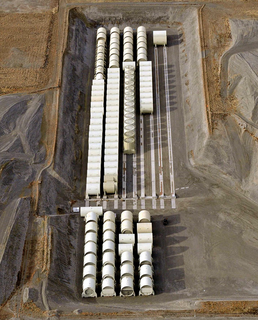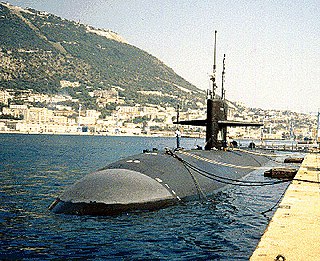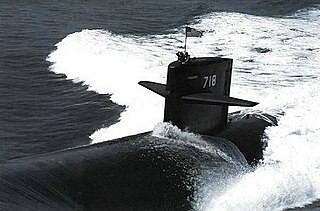The Ship/Submarine Recycling Program (SRP) is the process that the United States Navy uses to dispose of decommissioned nuclear vessels. SRP takes place only at the Puget Sound Naval Shipyard (PSNS) in Bremerton, Washington, but the preparations can begin elsewhere.

United States naval reactors are nuclear reactors used by the United States Navy aboard certain ships to generate the steam used to produce power for propulsion, electric power, catapulting airplanes in aircraft carriers, and a few more minor uses. Such naval nuclear reactors have a complete power plant associated with them. All U.S. Navy submarines and supercarriers built since 1975 are nuclear-powered by such reactors. There are no commissioned conventional (non-nuclear) submarines or aircraft carriers left in the U.S. Navy, since the last conventional carrier, USS Kitty Hawk, was decommissioned in May 2009. The U.S. Navy had nine nuclear-powered cruisers with such reactors also, but they have since been decommissioned. Reactors are designed by a variety of contractors, then developed and tested at one of several government owned and prime contractor-operated facilities: Bettis Atomic Power Laboratory in West Mifflin, Pennsylvania and its associated Naval Reactors Facility in Idaho, and Knolls Atomic Power Laboratory in Niskayuna, New York and its associated Kesselring site in West Milton, New York, all under the management of the office of Naval Reactors. Sometimes there were full-scale nuclear-powered prototype plants built at the Naval Reactors Facility, Kesselring, and Windsor to test the nuclear plants, which were operated for years to train nuclear-qualified sailors.

USS Sand Lance (SSN-660), a Sturgeon-class attack submarine, was the second ship and the second submarine of the United States Navy to be named for the sand lance, a member of the family Ammodytidae.

USS Nautilus (SSN-571) was the world's first operational nuclear-powered submarine and the first submarine to complete a submerged transit of the North Pole on 3 August 1958. Her initial commanding officer was Eugene "Dennis" Wilkinson, a widely respected naval officer who set the stage for many of the protocols of today's Nuclear Navy of the US, and who had a storied career during military service and afterwards.

USS Will Rogers (SSBN-659) was a Benjamin Franklin-class ballistic missile submarine – the last of the "41 for Freedom" Polaris submarines. She was the only ship of the United States Navy to be named for humorist Will Rogers (1879–1935).

USS Torsk, hull number SS-423, is a Tench-class submarine built for the United States Navy during World War II. Armed with ten torpedo tubes, the Tench-class submarines were incremental developments of the highly-successful Gato-class submarines that formed the backbone of the US Navy's submarine force during the war. Torsk was laid down at the Portsmouth Navy Yard in June 1944, was launched in September that year, and commissioned in December.

Nuclear marine propulsion is propulsion of a ship or submarine with heat provided by a nuclear reactor. The power plant heats water to produce steam for a turbine used to turn the ship's propeller through a gearbox or through an electric generator and motor. Nuclear propulsion is used primarily within naval warships such as nuclear submarines and supercarriers. A small number of experimental civil nuclear ships have been built.

USS James Monroe (SSBN-622), a Lafayette-class ballistic missile submarine, was the only ship of the United States Navy to be named for James Monroe. She served with the United States Navy from 1963 to 1990.

USS James Madison (SSBN-627), the lead ship of her class of ballistic missile submarine, was the second ship of the United States Navy to be named for James Madison (1751–1836), the fourth President of the United States (1809–1817).

USS Sam Rayburn (SSBN-635) was a James Madison-class fleet ballistic missile submarine named for Sam Rayburn (1882–1961), Speaker of the United States House of Representatives. Sam Rayburn was in commission 2 December 1964 to 31 July 1989 carrying the Polaris missile and later the Poseidon missile. Following decommissioning, ex-Sam Rayburn was converted into a moored training ship for use at the Naval Nuclear Prototype Training Unit at Goose Creek, South Carolina.

USS L. Mendel Rivers (SSN-686), a Sturgeon-class attack submarine in commission from 1975 to 2001, is the only ship of the United States Navy thus far to have been named for L. Mendel Rivers (1905–1970), U.S. Representative from South Carolina's 1st Congressional District (1941–1970).

USS Queenfish (SSN-651), a Sturgeon-class attack submarine, was the second ship of the United States Navy to be named for the queenfish, a small food fish found off the Pacific coast of North America.

USS Finback (SSN-670), a Sturgeon-class attack submarine, was the second ship of the United States Navy to be named for the finback, the common whale of the Atlantic coast of the United States.

USS Billfish (SSN-676), a Sturgeon-class attack submarine, was the second ship of the United States Navy to be named for the billfish, a name used for any fish, such as gar or spearfish, with bill-shaped jaws.

USS Atlanta (SSN-712), a Los Angeles-class submarine, was the fifth ship of the United States Navy to be named for Atlanta, Georgia. The contract to build her was awarded to Newport News Shipbuilding and Dry Dock Company in Newport News, Virginia, on 1 August 1975 and her keel was laid down on 17 August 1978. She was launched on 16 August 1980 sponsored by Mrs. Sam Nunn, and commissioned on 6 March 1982, with Commander Robin J. White in command.

USS Groton (SSN-694), the seventh Los Angeles-class submarine, was the third ship of the United States Navy to be named for Groton, Connecticut. The contract to build her was awarded to the Electric Boat Division of General Dynamics Corporation in Groton, Connecticut on 31 January 1971 and her keel was laid down on 3 August 1973. She was launched on 9 October 1976 sponsored by Mrs. Anne Francis Richardson, wife of Secretary of Commerce Elliot L. Richardson, and commissioned on 8 July 1978, with Commander R. William Vogel, III in command and Master Chief Petty Officer Joseph Pow as Chief of the Boat.

USS Buffalo (SSN-715) was a Los Angeles-class submarine, the second vessel that actively served the United States Navy to be named for Buffalo, New York. The contract to build her was awarded to Newport News Shipbuilding and Dry Dock Company in Newport News, Virginia on 23 February 1976, and her keel was laid down on 25 January 1980. She was launched on 8 May 1982 sponsored by Mrs. Joanne Kemp, wife of former Buffalo Bills quarterback and New York's 31st congressional district representative Jack Kemp, who was credited with winning approval to name the ship after the city in his district. Buffalo was commissioned on 5 November 1983, with Commander G. Michael Hewitt in command. Buffalo was decommissioned on 30 January 2019 after 35 years of service.

USS Olympia (SSN-717) is a Los Angeles-class submarine of the United States Navy. She is the 30th Los Angeles class nuclear powered fast attack submarine.

USS Honolulu (SSN-718), was a Los Angeles-class submarine, and the third ship of the United States Navy to be named for Honolulu, Hawaii. The contract to build her was awarded to Newport News Shipbuilding and Dry Dock Company in Newport News, Virginia on 15 September 1977 and her keel was laid down on 10 November 1981. She was launched on 24 September 1983 sponsored by Mrs. Joan B. Clark, and commissioned on 6 July 1985, with Commander Robert M. Mitchell in command.

USS Orion (AS–18) was a Fulton-class submarine tender of the United States Navy. She was laid down 31 July 1941 at the Moore Dry Dock Company, Oakland, California; launched 24 June 1942; sponsored by Mrs. Robert A. White; and commissioned 30 September 1943.





















